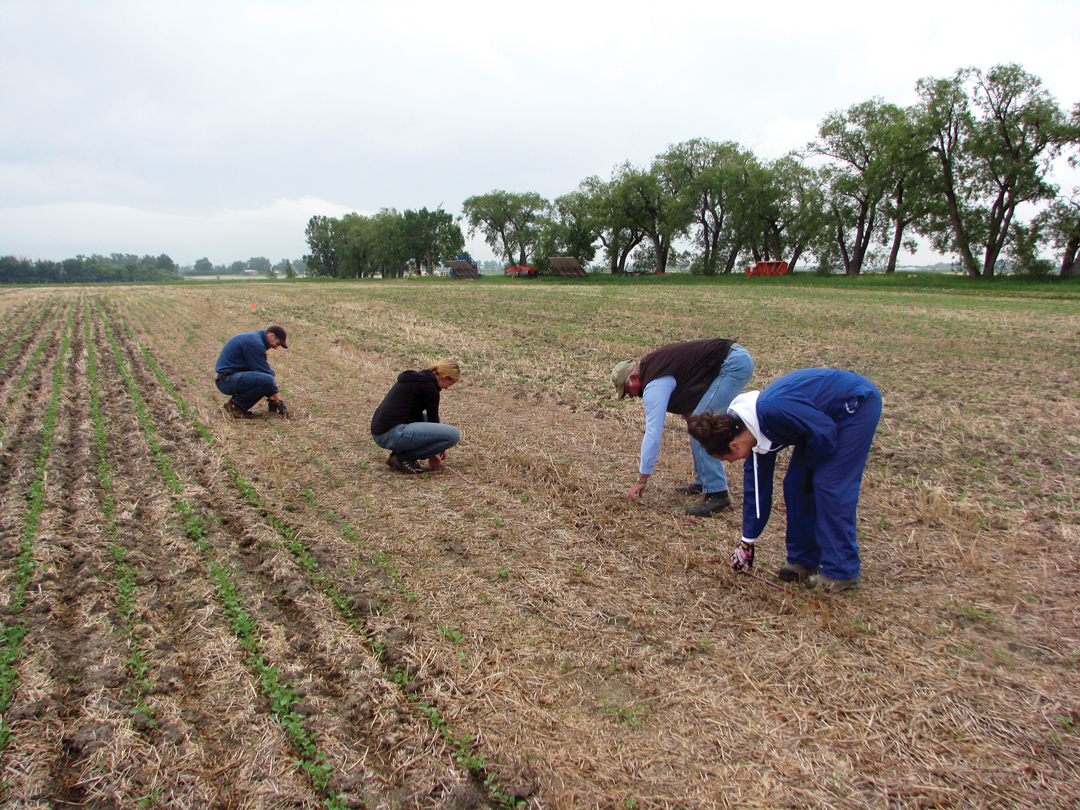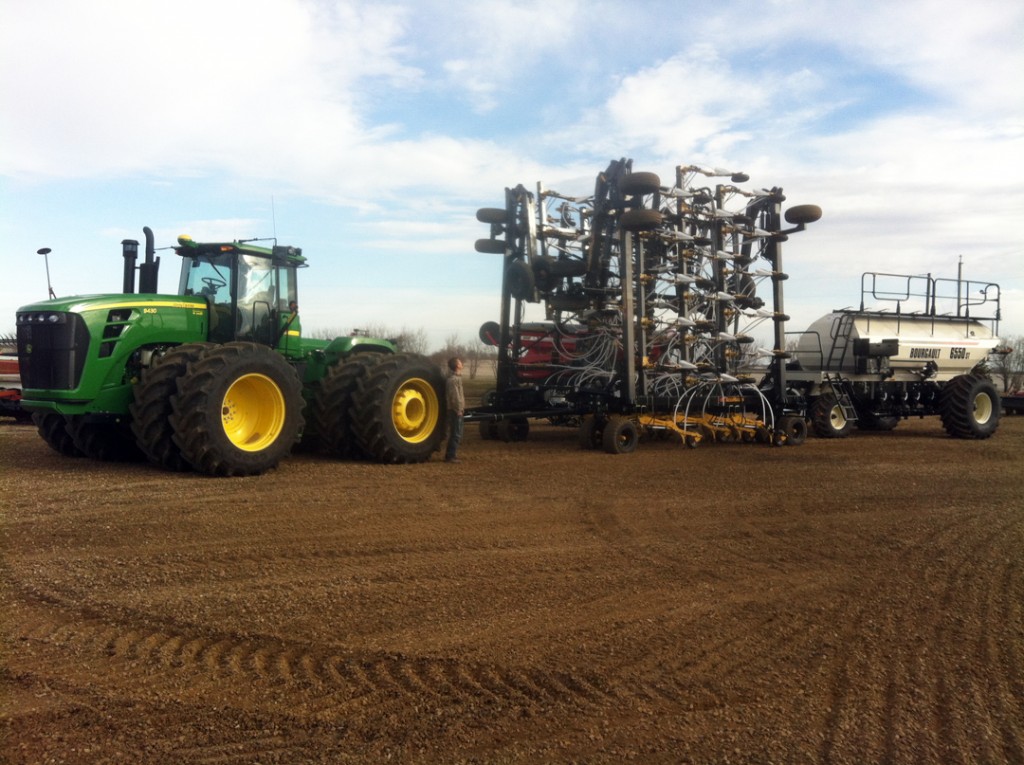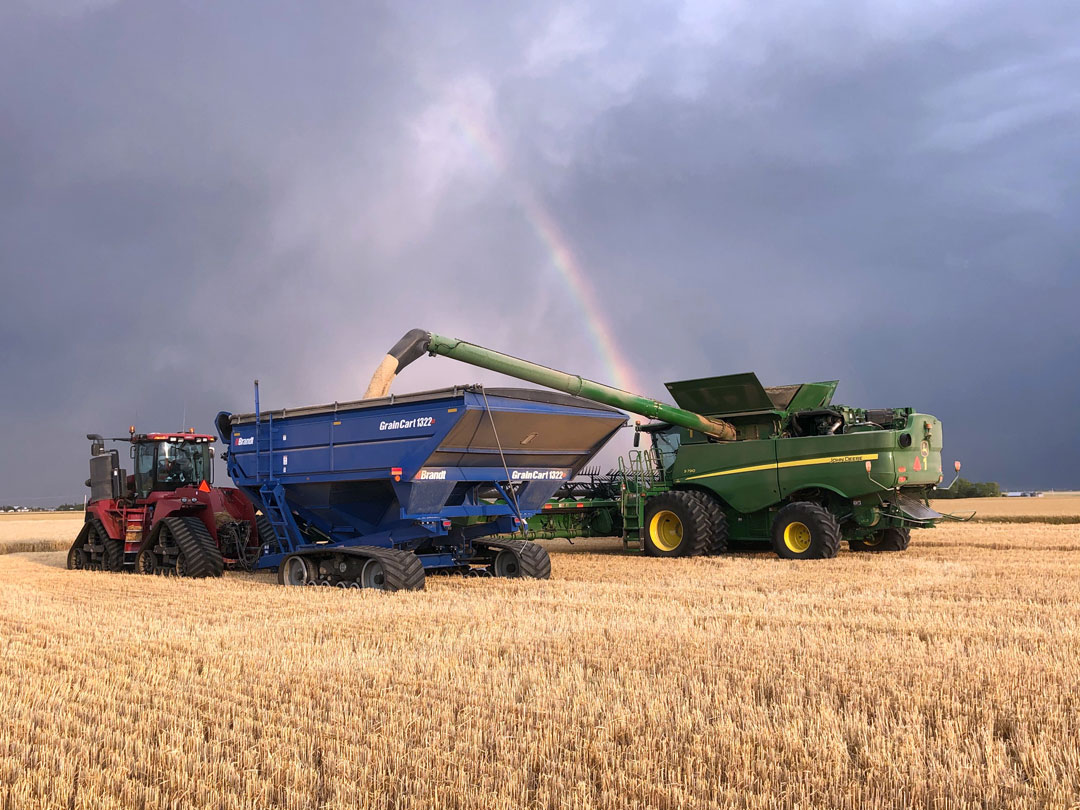POPULATION DENSITY
KEEP SEEDING RATES UP, AND SEED EARLY
BY LEE HART
Gerald Finster aims for a seeding rate that will produce about 22 plants per square foot on fields he’s seeding to Xena feed barley on his Peace River region farm.
Working with an Alberta Agriculture and Rural Development (AARD) seeding rate calculator, he seeds barley at 2.5 bushels per acre (with Xena that’s about 119.5 pounds of seed per acre) to achieve that 22 plants per square foot stand.
“Over the years, we’ve found that to be the optimal seeding rate for our farm,” said Finster, who, along with wife Esther and three sons, Kyle, Kevin and Josh, crops about 10,000 acres near Valleyview in the southern Peace River region. While he has seed batches tested for germination, he follows the bushel measure when it comes to seeding. It is based on the recommended 1,000-kernel weight formula. Barley samples of his bin-run seed weigh out at 43 per 1,000 kernels. The germination rate of seed batches is usually about 95 per cent and he estimates a 20 per cent seed mortality.
While seeding rates vary depending on soil zones, type of barley and growing region, as well as seed weight and quality, Finster is still within recommended AARD guidelines.
“We have nice, heavy seed and aim for that 2.5 bushel per acre seeding rate,” he said. “Over the years, we have found those rates are putting the target number of seeds in the ground and producing a good stand of barley.”
Finster follows a similar approach with wheat—targeting 25 plants per square foot. For example, this spring he’ll be seeding Stettler wheat weighing 39 grams per 1,000 kernels at a rate of 120 pounds, or two bushels per acre, to achieve the desired plant count.
“We can target a seeding rate, but the one unknown is the survival rate,” said Finster. “And you don’t know that until the crop comes up. We plan on about a 20 per cent mortality. We find with barley that, if we can seed it a bit later into nice, warm soil, it comes out of the ground fast and is very competitive with weeds. And the later seeding date works with barley because it matures faster.”
Most years, Finster plans to seed peas and/or wheat first in the spring, canola is seeded at about the mid-point, and oats and barley are seeded later.
“And the other thing we’ve found with barley is that it prefers lighter sandy loam and peat-type soils,” he said. “On the heavier soils, if you get too much moisture, barley doesn’t like to have wet feet, so it grows better on well-drained soils.”
RECOMMENDED SEEDING RATES
Finster’s approach to a barley seeding rate is right in the ballpark of what most researchers recommend for barley and, in fact, most cereal crop production—keep the seeding rate up so you’re achieving 22 to 30 and perhaps even 40 plants per square foot. That might be considered a heavy seeding rate or high plant count, but those numbers will increase the ability of the crop to compete with weeds and also help produce more even crop maturity.
According to Harry Brook, AARD crop specialist at the Ag Info Centre in Stettler, producers in the black soil zone should be targeting 25 to 30—even up to 40—plants per square foot under optimum growing conditions. The plant count should be somewhat less in the brown soil zone where moisture is often the limiting factor.
“Farmers should start with a target plant population in mind,” said Brook. “And of course, that will vary with soil and moisture conditions. Producers should aim for the higher rates in the black soil zone, and most years, although not always, lower rates in the brown soil zone because traditionally it is drier.”
Brook recommended farmers determine a seeding rate by using the 1,000-kernel weight formula (the calculator is available on AARD’s website).
“There is such variability in crops,” he said. “One batch of seed could weigh 60 pounds per bushel and another one 48 pounds. And in that heavier bushel you are going to get fewer seeds. So that 1,000-kernel weight will eliminate guesswork.”
Brook said that while barley tillers out less than wheat, those tillers mean the crop will have different stages or later overall maturity.
“We’ve had more cool, wet springs that have delayed seeding, which means crops are later maturing,” said Brook. “And on the other end, there is a chance of an early killing frost in September. So farmers need to do what they can to shorten crop maturity and reduce the risk of running into frost damage.”
John O’Donovan, a research scientist with Agriculture and Agri-Food Canada (AAFC) in Lacombe, said the results of 21 site years of research looking at malt barley seeding rates show that targeting 300 seeds per square metre (about 30 seeds per square foot) appears to be the optimum rate for malt barley yield and quality.
“One of the issues has been that maltsters are looking for kernel plumpness, so many farmers were using lower seeding rates to increase plumpness,” said O’Donovan. “But we found if the seeding rate was too low, bad things happened.”
For one, lower seeding rates increased the number of non-uniform kernels. The more uniform the kernels, the more malt quality is improved. Also, at lower seeding rates, there is more tillering and later maturity.
“Overall, we found that by going from 200 seeds per square metre to 300 seeds per square metre, we achieved higher yields, more uniform kernels and improved malt quality,” said O’Donovan. “There was a slight reduction in kernel plumpness, but we felt the uniformity of the seed was more important.”
The research also showed that at the 300-seed rate, protein was slightly lower, which is more desirable in malt barley. And by going from 200 to 300 seeds per square metre, crops matured two to three days sooner, “which can make a huge difference when quality is the key and frost can quickly damage a crop,” he said.
O’Donovan said it should be noted that his team’s research plots were direct seeded with an air seeding system calibrated for 300 seeds per square metre. With that system, they targeted 70 per cent emergence, or about 220 to 230 viable plants per square metre (about 22 to 23 plants per square foot).
“So if you have a seeding system where you are expecting 95 per cent emergence, for example, then you would need to adjust your seeding rate so you end up with about 220 to 230 plants per square metre,” he said.
Going beyond 300 seeds per square metre didn’t help with malt barley, said O’Donovan. At 400 and 500 seeds per square metre, yield was significantly reduced, likely due to lodging, and the economics of higher costs associated with the higher rate didn’t pencil out.
In southern Alberta, Ross McKenzie, a longtime AARD research scientist now retired, said his research with crops produced under irrigation showed the optimum seeding rate for malt barley was 17 to 24 plants per square foot (he targeted 180 to 250 seeds per square metre).
For feed barley under irrigation, it was slightly higher at 19 to 33 plants per square foot (200 to 350 seeds per square metre). And for Hard Red Spring Wheat under irrigation, 19 to 28 plants per square foot (200 to 300 seeds per square metre).
McKenzie said that while every seeding system is different, he figures on an average emergence of between 60 and 80 per cent.
“With most seeding systems, if you are targeting a one-inch seeding depth, for example, you’re going to get some seeds at half an inch depth and some at two inches,” said McKenzie. “So you have to adjust the actual number of seeds planted to achieve the targeted viable plant count.”
Looking at wheat production in dryland farming, McKenzie said some of his last research published in 2013 showed the optimum seeding rate for soft white wheat in all soil zones was 300 to 400 seeds per square metre (roughly 30 to 40 seeds per square foot), which should translate into about 21 to 28 plants per square foot.
With Canada Prairie Spring Wheat on dryland, seeding rates ranged from 275 to 350 seeds per square metre (28 to 35 seeds per square foot), or a plant count of 20 to 25 plants per square foot in the dark brown soil zone, and up to about 350 to 450 seeds per square metre or 25 to 32 plants per square foot in the black soil zone.
McKenzie’s research papers, entitled Optimum Seeding Date and Rates for Irrigated Grain and Oilseed Crops and Dryland Agronomic Management of Soft White Spring Wheat and Canada Prairie Spring Wheat in Alberta, can both be found on the AARD website: https://www.agric.gov.ab.ca/app21/infopage?cat1=Crops&cat2=Cereals.
SEED AS EARLY AS POSSIBLE
Along with the seeding rate, McKenzie said another important factor for farmers to consider is the seeding date. Generally, researchers and crop specialists suggest an early seeding date is better than a late seeding date.
“Obviously, you can’t seed every crop on the same day,” said McKenzie. “But, research shows yield is reduced by about one per cent per day for each day the crop is seeded after May 1.”
His research showed flax was the least affected by delayed seeding, losing about 0.6 per cent yield per day after May 1, while canola was the most affected, losing about 1.7 per cent of yield for each day seeding was delayed after May 1. Most of the cereal crops were in the range of one to 1.3 per cent per day.
“The earlier you can get your crop seeded without risk of damage, the better,” said McKenzie. “You may not want to seed canola on April 15 due to the risk of frost, but you may want to consider getting your peas, wheat and barley seeded in late April if conditions are suitable.”
McKenzie said farmers should look to get their highest-value crops seeded first (to protect yield potential) and then schedule the rest of the crops later.
“If you can’t seed until May 1, and canola is your highest-value crop, then it would be best to seed canola first,” said McKenzie. “Then follow that with wheat and then barley. Since flax, for example, has the least potential for yield loss due to later seeding, you could seed it last.”
According to Brook, temperature is an important factor when it comes to seeding early.
“You don’t want to be seeding into damp soil that is only 1°C,” he said. “You can lose a lot of seed to rot under those conditions.
“As a minimum, soil needs to be 5°C or better at time of seeding. If you can seed into a warm, moist seedbed, and seed shallow, that crop has an excellent chance of getting off to a good start. You might be able to seed peas at 4°C, but overall it is best to wait for at least 5°C before seeding.”
O’Donovan had similar recommendations following his research with malt barley.
“In most areas we found that seeding early—seeding before the middle of May—produced the better yields,” he said. “The exception to that might be the Peace River region, where waiting a bit later, until after the middle of May, produced the best results.”
O’Donovan attributed that simply to cooler growing conditions in the Peace region earlier in the year.
“For most of the Prairies, except for the Peace region, earlier seeding of malt barley produced higher yields, improved quality characteristics and lower protein,” he said. “With later seedings, the protein increased.”
OATS ARE SPECIAL
Oats require a heavier seeding rate than either wheat or barley, according to Bill May, an AAFC researcher at Indian Head, SK.
Extensive research has shown producers should target a minimum of 300 live plants per square metre (about 30 per square foot) to produce an optimal, high-yielding stand that matures evenly and competes against weeds.
“Oats have more variability than any other cereal crop we grow,” said May. “So to determine the proper seeding rate it is really important to determine the weight of your oat seed batch using the 1,000-kernel weight formula. And we have found there is more difference between seed lots than there is between cultivars. So you just can’t say that, because you grow a certain variety, the seeding rate should be this amount. You need to calculate that 1,000-kernel weight for each seed lot.”
Comparing it to a bushel measure to achieve 300 live plants per square metre (three square feet), May has seen bushel measures vary from 2.2 to four bushels per acre, depending on the seed batch.
May said a live plant stand of about 30 plants per square foot produces even maturity for farmers planning to straight combine the crop. And that stand density provides fairly good suppression of what he described as “a light wild oat infestation.”
He explained that, if producers are facing a heavy wild oat infestation, they need to bump the seeding rate to 350 to 375 live plants per square metre (about 35 to 38 plants per square foot).
“When it comes to controlling wild oats in oats, seeding rate is about the only option farmers have,” he said. “They need to establish a proper plant stand to compete against the weed. There is no real adverse affect in going to the higher seeding rate other than increasing the cost of seed.
“If farmers have a lower plant count with oats, they are really going to lose ground against wild oats. That 300 to 350 live plant count is really quite effective at knocking back wild oats.”
According to May, an earlier seeding date is better than a later seeding date—both in terms of yield and crop quality.
“It depends what the producer is after, but if they are looking for a high-yielding, milling-quality oat with a higher test weight, an earlier seeding date is best. It is best to seed oats in the first half of May rather than in late May or early June.”
He said research shows as much as a 50 per cent yield loss between oats seeded in mid-June versus oats seeded in mid-May, and test weight drops significantly with the June seeding, as well.
“And that recommendation will vary, too, depending on what part of the province or Prairies you are seeding in,” said May. “The test weight increases as you seed from south to north. Test weights are going to be higher in areas with cooler, moister growing conditions. For example, and I emphasize this is usually the case, if you seeded oats on the same day at Indian Head and then 100 miles north at Ituna, the oats at Ituna would have a higher test weight because of the ‘usual’ cooler growing conditions.”
May said another way to look at it for farmers in the southern Prairies is that it’s best to seed oats in early May to protect test weight because of the usual hot, dry conditions during the growing season, whereas farmers in central and northern areas could probably seed oats the second or third week of May and still achieve very good test weights.








Comments